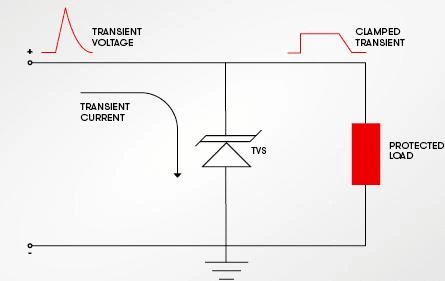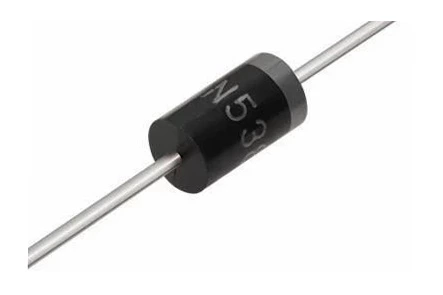Guide To Tvs Diodes: From Working Principles To Selection Process
In the fast-evolving electronics industry, whether it's consumer electronics, automotive, telecommunications, or industrial control systems, all circuits face a common challenge—transient overvoltage. Sudden high-voltage events such as electrostatic discharge (ESD), lightning strikes, or inductive kickbacks can instantly damage chips and burn out circuits.
TVS diodes (Transient Voltage Suppression Diodes) are specially designed devices to protect against such high-energy transient voltages. They act like “lightning rods” in circuits, responding quickly when a sudden voltage spike occurs to safely dissipate the threat.
This article introduces the working principles, key performance parameters, device classifications, and selection tips of TVS diodes, helping you gain a systematic understanding of this crucial protection component.
1. What Is a TVS Diode and How Does It Work?

A TVS diode is a semiconductor protection device that normally remains in a high-impedance state, not affecting normal circuit operation. When the voltage exceeds the breakdown voltage, the TVS diode quickly conducts, diverting the overvoltage to ground and protecting downstream components from damage. After the transient, it automatically returns to a high-impedance state and can be used repeatedly.
Example: When a person’s static discharge hits an electronic device interface, the TVS diode responds within nanoseconds to prevent chip breakdown from high voltage.
2. Differences Between TVS and Other Protection Devices
| Protection Device | Response Speed | Clamping Accuracy | Reusability | Typical Applications |
|---|---|---|---|---|
| TVS Diode | < 1 ns | Precise | Strong | ESD, surges, power line protection |
| Metal Oxide Varistor (MOV) | Microseconds | Moderate | Moderate | Lightning, power line protection |
| Gas Discharge Tube (GDT) | Microseconds to milliseconds | No clamping | Strong | Industrial surges, high-current scenarios |
| ESD-specific TVS | < 1 ns | Extremely low clamp voltage | Weak | USB, HDMI, Ethernet high-speed ports |
Summary: TVS diodes respond fastest and clamp most accurately, making them ideal for protecting sensitive IC inputs. MOVs and GDTs have their strengths in handling larger energy surges.
3. Key Parameters of TVS Diodes
When choosing a TVS diode, pay attention to:
-
Vrwm (Maximum Working Voltage): Should be slightly higher than the normal system voltage.
-
Vbr (Breakdown Voltage): The voltage at which the TVS diode begins to conduct.
-
Vclamp (Clamping Voltage): The maximum voltage allowed during a surge, must be below the protected device’s voltage rating.
-
Ipp (Peak Pulse Current): Maximum transient current the device can safely absorb.
-
Response Time: Typically < 1 ns, ensuring quick voltage clamping.
-
Junction Capacitance: For high-speed signals, < 1 pF is preferred to avoid signal distortion.
4. Common Categories of TVS Diodes

By conduction direction:
-
Unidirectional TVS: Suitable for DC power lines.
-
Bidirectional TVS: Suitable for AC signals and bidirectional data lines (e.g., USB, RS-485).
By package type:
-
Surface-mount devices (SMD): Examples include SOD-323, SOT-23, ideal for miniaturized products.
-
Through-hole devices: Examples include DO-15, P6KE, suitable for industrial and high-power applications.
-
Array devices: Provide multi-line protection, used in USB hubs, keyboard matrices, etc.
5. Typical Application Scenarios
-
USB/HDMI interfaces: Prevent voltage spikes caused by static and hot-plugging.
-
Automotive electronics: Protect ignition systems, motor drives from reverse voltage.
-
LED driver circuits: Shield drivers from power fluctuations.
-
Industrial I/O interfaces: Protect PLCs, industrial Ethernet from surge and lightning.
-
Power input stages: Used together with MOVs, GDTs for multi-level protection.
6. How to Correctly Select a TVS Diode?
-
Confirm system voltage: Vrwm ≥ normal operating voltage.
-
Check the protected device’s voltage tolerance: choose Vclamp < device max voltage.
-
Assess surge strength: select Ipp based on environmental conditions.
-
Consider package and PCB space: SMD for compact designs, through-hole for high-power needs.
-
Determine if high-speed signals are involved: prioritize low junction capacitance models.
-
Verify standards certification: such as IEC 61000-4-2 Level 4 ESD requirements.
7. Application Example: USB Interface Protection Against Transient Overvoltage
For a USB 2.0 interface:
-
TVS type: bidirectional low-capacitance model;
-
Vrwm: 5 V;
-
Vclamp: < 9 V;
-
Junction capacitance: < 0.5 pF;
-
Layout recommendation: place close to the connector, keep trace lengths short, ensure low-resistance grounding for fast response and effective clamping.
8. Conclusion
Though small, TVS diodes are indispensable “gatekeepers” in electronic systems. In environments with frequent transient overvoltages, proper device selection and optimized PCB layout maximize protection for sensitive components and improve product reliability.